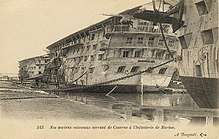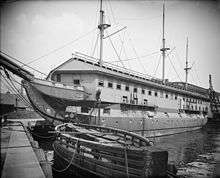Barracks ship
A barracks ship or barracks barge, or in civilian use accommodation vessel or accommodation ship, is a ship or a non-self-propelled barge containing a superstructure of a type suitable for use as a temporary barracks for sailors or other military personnel. A barracks ship, a military form of a dormitory ship, may also be used as a receiving unit for sailors who need temporary residence prior to being assigned to their ship.
_is_moored_alongside_the_U.S._Naval_Academy's_Dewey_Seawall.jpg)
Early use


Barrack ships were common during the era of sailing ships when shore facilities were scarce or non-existent. Barrack ships were usually hulks. At times, barrack ships were also used as prison ships for convicts, prisoners of war or civilian internees.
Use in World War II
Barracks ships in the combat area provided necessary residence for sailors and merchantmen whose ship had been sunk, or whose ship had been so damaged that on-board berthing was no longer possible. They were also used at advanced bases, and as mobile barracks for units such as construction battalions. Occasionally, they would be used for other roles such as providing office space.
APL were non-self-propelled barracks ships were used by the United States Navy in forward areas during World War II, especially in the Pacific Ocean, and were designated APL, such as APL-18 which was commissioned in 1944 and had the following specifications for APL-1 to APL-58:
- Displacement 1,300 t.(lt), 2,580 t.(fl)
- Length 261 ft (80 m)
- Beam 49 ft (15 m)
- Draft 11 ft (3.4 m)
- Complement unknown
- Accommodations 5 Officers, 358 Enlisted
APB-35 to APB-51 were propelled Barracks Ship built in 1944. APB has a full load displacement of 2,190 tons.
Transport ships were also used as barracks by other war-time navies, such as the Kriegsmarine's SS General San Martin. One of the two abortive Jade class auxiliary aircraft carriers (Elbe) was also converted into a barracks ship.
Subsequent use
The United Kingdom used barracks ships to help garrison the Falkland Islands after it ousted the Argentinian occupation force in the 1982 Falklands War. The former car ferries MV St Edmund and TEV Rangatira were deployed to Port Stanley in 1982, and Rangatira stayed until September 1983.[1]
Rangatira is also an example of a civilian accommodation ship. She and another former ferry, MV Odysseus, housed workers who built an oil platform in Loch Kishorn in Scotland in 1977–78, and Rangatira housed workers who built Sullom Voe Terminal in the Shetland Islands in 1978–81.[1]
References
- Castell, Marcus (2003–2005). "The Turbo Electric Vessel Rangatira of 1971". The New Zealand Maritime Record. Retrieved 29 May 2013.
- This article incorporates text from the public domain Dictionary of American Naval Fighting Ships.